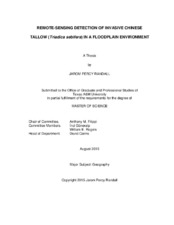| dc.description.abstract | Chinese tallow (Tradica sebifera) is an established invasive species in many southern woodlands in the United States. Its ability to adapt and spread quickly into disturbed areas has made it an invasive species of much concern to land managers. Riparian/floodplain environments have been affected by tallow as much as upland areas and entail a high degree of Chinese tallow invasion. Remote sensing is a tool that may provide a means of detecting, or classifying, Chinese tallow. There have been very few studies that have attempted to map Chinese tallow in a floodplain environment.
This research focused on mapping Chinese tallow on a single river meander bend. The purpose of this study was to determine which of the nonparametric detection methods considered, such as Multivariate Regression Splines (MARS), Stochastic Gradient Boosting (SGB) and the Random Forest (RF) models, as well as common spectral-extraction algorithms, were able to most accurately detect Chinese tallow in a floodplain forest based on remote-sensing data. In addition, it was the purpose of this study to attempt to determine factors affecting tallow growth and spread, and to map the spatial distribution of tallow in the study area.
Fieldwork was conducted in 2010 and 2014 to acquire Chinese tallow presence/absence information to be used for classification model training and testing. A hyperspectral Hyperion satellite image from summer 2010 constituted the primary remote-sensing data source, as well as airborne LiDAR data.
The three nonparametric models tested were used to predict Chinese tallow occurrences in the study area. A variety of input variables were employed in the modeling process, including: Hyperion image bands, dimensionality-reduced Minimum Noise Fraction (MNF) images, vegetation indices, and topographic and soil variables. An endmember-based approach was also used to classify tallow presence but was not very successful.
Results show that the most accurate dataset-combination trials involving both SGB and MARS yield high overall classification accuracy, 92.85%, whereas the most accurate RF dataset-combination trial provides lower overall classification accuracy, at 80%. Both spatial and aspatial statistical analyses were performed on the classification results. Significance testing indicates that the most accurate RF classification is not statistically significantly different from the most accurate SGB and MARS classifications. However, other error matrix significance testing finds the most accurate RF classification to be statistically significantly different from the most accurate SGB and MARS Chinese tallow classifications. A hot-spot analysis revealed that homogenous areas classified as tallow or as non-tallow can be detected and identified. Results from this study are promising in many areas of the meander bend, such as the transition zone where tallow is prevalent but less so in areas that have more established forest. Some methods tested were successful in detecting tallow and their use may aid land managers in the managing Chinese tallow growth and spread. | en |


